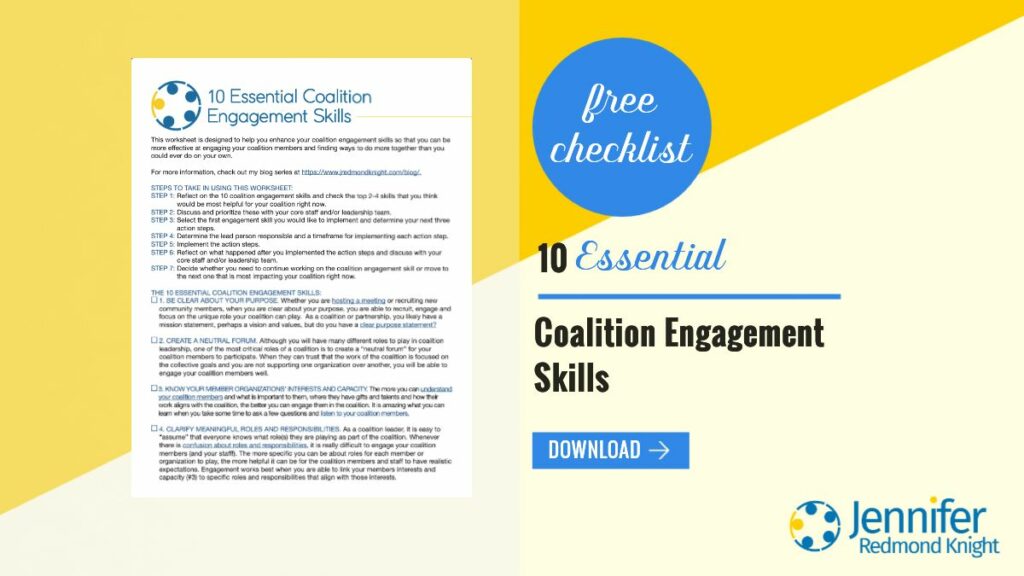Engaging coalition members (who are usually volunteers to the coalition) can be extremely challenging. We can struggle with recruiting the right people to participate, keeping them engaged and helping them follow-through with coalition tasks even though they have full-time jobs. We also can struggle with figuring out the best way to share and exchange information when we are all over-loaded with information. We know we need to spend time building relationships but we have limited time because we are trying to manage grant, contract or board of directors’ expectations. The reason we are coalition leaders is because we believe in our mission and we know that if we build true partnerships, we can do much more together than we ever could on our own. Although we know we “need” to have a coalition (especially in public health settings), we rarely talk about what is really needed to engage our coalitions. Over the next 10 weeks, I want to help you build your coalition engagement skills. Join me this week as I provide an overview of my “top 10” essential coalition engagement skills.
We have a complimentary checklist that you can download for free. It gives into even more detail and gives you practical actions you can take to become a more effective coalition leader. Download it now.
Be clear about your purpose
This is true for everything you do with your coalition. Whether you are hosting a meeting or building community engagement, when you are clear about your purpose, you are able to identify, recruit, connect and engage participants to collaborate. As a coalition or partnership, you likely have a mission statement, perhaps a vision and values, but do you have a clear purpose statement? As you provide leadership for your coalition, you are balancing the needs of communities, regions and organizations who want to do a lot of different things and address many different needs related to your topic area or cause. This can be really exciting but it can also become very overwhelming. This also makes it difficult for the organizations participating in your coalition to understand the role of the coalition overall as well as their role as a coalition member. When we are overwhelmed and confused about roles and responsibilities, it can be really difficult to figure out how to work together better to accomplish collective goals and to encourage active participation. When we are clear about our purpose, we can focus, prioritize and more effectively work together which helps us keep our coalition engaged.
Create a neutral forum
Your coalition members participate in the coalition because the work aligns with their own work and/or areas of passion and interest. When you bring together diverse coalition members from communities, groups and organizations, there will often be competition among members. Although you will have many different roles to play in coalition leadership, one of the most critical roles of a coalition is to create a “neutral forum” for your coalition members to participate. When they can trust that the work of the coalition is focused on the collective goals and you are not supporting one organization over another, you will be able to engage your coalition members well and encourage collaboration. When you are able to create a neutral forum and facilitate meetings that help every member succeed, you will build and maintain engagement.
Know your member organizations’ interests and capacity.
The more you can understand your coalition members and what is important to them, where they have gifts and talents and how their work aligns with the coalition, the better you can engage them in the coalition. It is amazing what you can learn when you take some time to ask a few questions and listen to your coalition members. Take notes on what you learn and then consider that information as you develop your priorities, workgroups and teams. If you have read my blog for very long, you have probably heard me mention Stephen Covey. One leadership principle that is particularly important here is Seek first to understand, then be understoodⓇ. When you are able to understand and clearly articulate what is important to your coalition members, they will become more engaged.
Clarify meaningful roles and responsibilities.
As a coalition leader, it is easy to “assume” that everyone knows what role(s) they are playing as part of the coalition. If you are working in a coalition with like-minded organizations, it is easy to encounter competition among the organizations and confusion about roles in the coalition. You may also have different expectations for the roles of staff, leaders and coalition members. Whenever there is confusion about roles and responsibilities, it is really difficult to engage your coalition. If you have a work plan or action plan, include information about specific roles for each organization participating in each task or activity. The more specific you can be about roles, the more helpful it can be for the coalition leaders, members and staff to have realistic expectations. Engagement works best when you are able to link your members interests and capacity (#3) to specific roles and responsibilities that align with those interests.
Facilitate conversations and connections
One of the most important roles for a coalition leader to play is that of a “master facilitator.” It can be easy to think you have to be the one to “do” everything in the coalition; however, if you are really going to be able to achieve more together than you can on your own, you will succeed by facilitating conversations and connections. One of the benefits of being part of a coalition is the ability to connect with others and develop mutually beneficial partnerships. When you facilitate conversations (oftentimes meetings), you create an opportunity for your coalition members to fulfill their best role and to complement the roles of others. When you are able to facilitate conversations and connections, you are able to guide your coalition members toward active engagement.
Demonstrate energy and enthusiasm.
While this is important for in-person coalition meetings, it is even more critical when you are trying to engage coalitions virtually. As a coalition leader, you are responsible for modeling and encouraging positive energy. When you demonstrate enthusiasm and high-levels of energy, it is contagious (in the best way possible) 🙂 You are able to bring out the best in others, help the coalition consider challenges as opportunities and create a forum for high levels of community engagement. Demonstrating energy and enthusiasm helps your coalition members become excited about working together and can help them continue to work together even when things may become difficult.
Show empathy.
As a coalition leader, you never know what may be happening in the lives of your coalition members. They may be feeling completely overwhelmed, may have just found out about a promotion or they may have just been told their budget was cut again. They may have lost their job, been furloughed or have a new boss who does not understand or support their work. They may be struggling with many personal challenges as well – caregiving, parenting, health issues or difficult family or friend relationships. One of the most important coalition leadership skills is to show empathy and compassion when your coalition members are struggling to give their best and engage in the coalition. Empathy is not about fixing someone or telling someone that you understand what they are experiencing. Empathy is listening, caring and supporting others. Empathy is being willing to sit with someone during very difficult situations without having any “words” to say. Empathy is believing the best in others. Empathy is not having an agenda for someone else but a willingness to walk beside them and really learn what is most important to them. When you show empathy for your coalition members, you will build trust, strengthen the relationship and will support engagement in the coalition. Even if they cannot actively participate for a time, if you show empathy, when they can be involved again, they will be!
Conduct effective meetings.
One of the most important things you do in coalition work is conduct meetings. When you are able to conduct effective meetings, your coalition members will want to attend those meetings and are more likely to actively participate in the meeting and engage in the follow-up. Effective meetings don’t just “happen.” It takes thoughtful consideration, preparation and follow-up in order to conduct effective meetings. You need to have a clear purpose for why you are meeting and what you want to accomplish during the meeting. You need to know which coalition members to invite to the meetings, when you want to meet, what type of meeting would be best in order to accomplish your purpose, plan logistics for the meeting and facilitate the meeting well. Once the meeting is over, you need a clear plan for follow-up, action items and people responsible. If you conduct effective meetings, your coalition members will trust that your meeting is a good use of time and it will be much easier to engage them in your collective work.
Communicate clearly and consistently.
When you are leading a coalition, you may feel like you are always talking about what you are doing and can sometimes start to think that everyone else knows what you are doing too. 🙂 Even though our coalition members can be easily overwhelmed by emails, if there is infrequent and only occasional communication with only a few coalition members, the overall coalition will lose interest and engagement. Also, you also want to communicate as clearly as possible. Keep your emails as short as possible and use bullet points, pictures and tables. Be strategic about your meetings – from frequency to length to content so that you are clear and consistent.
Find “win-win” opportunities.
One of the most effective ways to engage your coalition members is to connect what is most important and beneficial to the coalition members as well as the coalition. Once again, Stephen Covey has created an important leadership principle that can apply to coalition engagement, Think Win-WinⓇ. In order to really understand what is a “win” for your coalition, apply #1 (Be clear about your purpose) and for a “win” for your coalition members, apply #3 (Know your members interests and capacities) and #4 (Clarify meaningful roles and responsibilities). When you combine these leadership concepts, you will practice thinking “win-win” which results in active engagement in your coalition. The work benefits the purpose of the coalition as well as the individual members.
As you reflect on these skills, prioritize one to three areas you would like to work on as a coalition. Download my newest free resource where I provide additional guidance on how to develop these skills that will help you keep your coalition engaged.
So what about you? Which of these skills have you found particularly successful in engaging your coalition members?
If you missed my Facebook Live on this post, check it out here!


